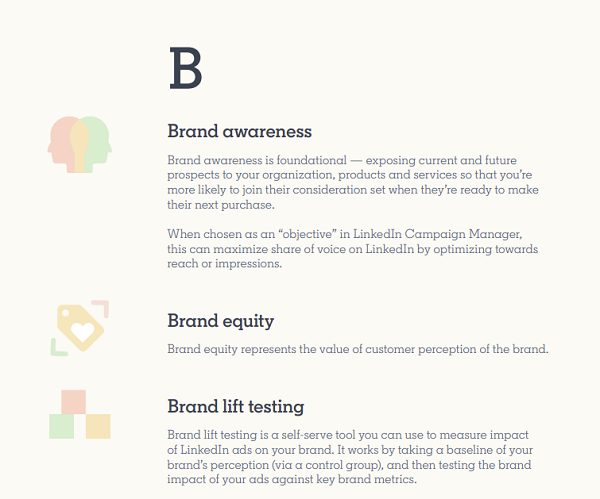SOCIAL
LinkedIn Publishes New Glossary of Marketing Terms to Help Improve Understanding

Do you ever find yourself lost among the jargon when you’re trying to research a new marketing update, or trying to stay on top of the latest metrics to track, in order to measure your brand performance?
Marketers love an acronym, and the deeper you get into the process, the more confusing it gets, with every TOFU, BOFU, AOV and MER reference all serving to further entrench those already ‘in the know’, and filter out the pretenders looking to keep up.
So how can you go from ‘pretender’ to ‘expert’ – or even on a more basic level, how can you just stay up with the more commonly applicable references to ensure that you can understand the elements you need to maximize for your own ad efforts?
This new guide from LinkedIn aims to provide some assistance – and while it won’t serve as a talisman to navigate all the online marketing jargon, it could help you get your head around some of the main, common concepts.
LinkedIn’s 9-page ‘Ultimate Glossary of Brand Building Terms’ is fairly brief, but it does cover many of the basic terms.
The guide is presented in alphabetical order, with a range of terms explained.

There are also some stranger ones, that kind of feel like they need no explanation:

But maybe, within a marketing-specific context, it’ll help establish a better grounding for your process, which could make it easier to navigate the key information you require.
I mean, not on Social Media Today – we work to try and explain things as clearly as we can so you don’t need to be a marketing expert to know what each update means for your business. But in general terms, as you look to build your digital marketing knowledge, it is handy, at times, to have a reference point like this to help you stay on top of exactly what each update and process actually means, practically, for you and your brand.
It’s brief, and there’s not a heap to it, but it could be a helpful addition for your process.
You can download LinkedIn’s ‘Ultimate Glossary of Brand Building Terms’ pocket guide here.
SOCIAL
Snapchat Explores New Messaging Retention Feature: A Game-Changer or Risky Move?

In a recent announcement, Snapchat revealed a groundbreaking update that challenges its traditional design ethos. The platform is experimenting with an option that allows users to defy the 24-hour auto-delete rule, a feature synonymous with Snapchat’s ephemeral messaging model.
The proposed change aims to introduce a “Never delete” option in messaging retention settings, aligning Snapchat more closely with conventional messaging apps. While this move may blur Snapchat’s distinctive selling point, Snap appears convinced of its necessity.
According to Snap, the decision stems from user feedback and a commitment to innovation based on user needs. The company aims to provide greater flexibility and control over conversations, catering to the preferences of its community.
Currently undergoing trials in select markets, the new feature empowers users to adjust retention settings on a conversation-by-conversation basis. Flexibility remains paramount, with participants able to modify settings within chats and receive in-chat notifications to ensure transparency.
Snapchat underscores that the default auto-delete feature will persist, reinforcing its design philosophy centered on ephemerality. However, with the app gaining traction as a primary messaging platform, the option offers users a means to preserve longer chat histories.
The update marks a pivotal moment for Snapchat, renowned for its disappearing message premise, especially popular among younger demographics. Retaining this focus has been pivotal to Snapchat’s identity, but the shift suggests a broader strategy aimed at diversifying its user base.
This strategy may appeal particularly to older demographics, potentially extending Snapchat’s relevance as users age. By emulating features of conventional messaging platforms, Snapchat seeks to enhance its appeal and broaden its reach.
Yet, the introduction of message retention poses questions about Snapchat’s uniqueness. While addressing user demands, the risk of diluting Snapchat’s distinctiveness looms large.
As Snapchat ventures into uncharted territory, the outcome of this experiment remains uncertain. Will message retention propel Snapchat to new heights, or will it compromise the platform’s uniqueness?
Only time will tell.
SOCIAL
Catering to specific audience boosts your business, says accountant turned coach

While it is tempting to try to appeal to a broad audience, the founder of alcohol-free coaching service Just the Tonic, Sandra Parker, believes the best thing you can do for your business is focus on your niche. Here’s how she did just that.
When running a business, reaching out to as many clients as possible can be tempting. But it also risks making your marketing “too generic,” warns Sandra Parker, the founder of Just The Tonic Coaching.
“From the very start of my business, I knew exactly who I could help and who I couldn’t,” Parker told My Biggest Lessons.
Parker struggled with alcohol dependence as a young professional. Today, her business targets high-achieving individuals who face challenges similar to those she had early in her career.
“I understand their frustrations, I understand their fears, and I understand their coping mechanisms and the stories they’re telling themselves,” Parker said. “Because of that, I’m able to market very effectively, to speak in a language that they understand, and am able to reach them.”Â
“I believe that it’s really important that you know exactly who your customer or your client is, and you target them, and you resist the temptation to make your marketing too generic to try and reach everyone,” she explained.
“If you speak specifically to your target clients, you will reach them, and I believe that’s the way that you’re going to be more successful.
Watch the video for more of Sandra Parker’s biggest lessons.
SOCIAL
Instagram Tests Live-Stream Games to Enhance Engagement

Instagram’s testing out some new options to help spice up your live-streams in the app, with some live broadcasters now able to select a game that they can play with viewers in-stream.
As you can see in these example screens, posted by Ahmed Ghanem, some creators now have the option to play either “This or That”, a question and answer prompt that you can share with your viewers, or “Trivia”, to generate more engagement within your IG live-streams.
That could be a simple way to spark more conversation and interaction, which could then lead into further engagement opportunities from your live audience.
Meta’s been exploring more ways to make live-streaming a bigger consideration for IG creators, with a view to live-streams potentially catching on with more users.
That includes the gradual expansion of its “Stars” live-stream donation program, giving more creators in more regions a means to accept donations from live-stream viewers, while back in December, Instagram also added some new options to make it easier to go live using third-party tools via desktop PCs.
Live streaming has been a major shift in China, where shopping live-streams, in particular, have led to massive opportunities for streaming platforms. They haven’t caught on in the same way in Western regions, but as TikTok and YouTube look to push live-stream adoption, there is still a chance that they will become a much bigger element in future.
Which is why IG is also trying to stay in touch, and add more ways for its creators to engage via streams. Live-stream games is another element within this, which could make this a better community-building, and potentially sales-driving option.
We’ve asked Instagram for more information on this test, and we’ll update this post if/when we hear back.
-

 PPC5 days ago
PPC5 days agoHow 6 SEO Experts Are Navigating Google Update Chaos
-

 MARKETING7 days ago
MARKETING7 days ago12 Facebook Ad Metrics Worth Your Attention
-

 WORDPRESS4 days ago
WORDPRESS4 days ago10 WordPress Influencers to Follow in 2024 – WordPress.com News
-

 SEARCHENGINES5 days ago
SEARCHENGINES5 days agoBing Search Testing Removing Cache Link From Search Results
-

 MARKETING5 days ago
MARKETING5 days ago60 Remote Work Stats to Know in 2024
-

 SEO6 days ago
SEO6 days agoGoogle Explains How It Chooses Canonical Webpages
-

 SEO6 days ago
SEO6 days agoThe Essential Guide To Using Images Legally Online
-

 SEARCHENGINES6 days ago
SEARCHENGINES6 days agoOngoing Google March Core Update, Googlebot To Crawl Less, Pay For Google Search AI & More


